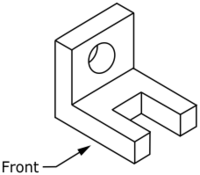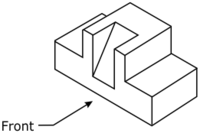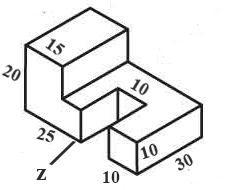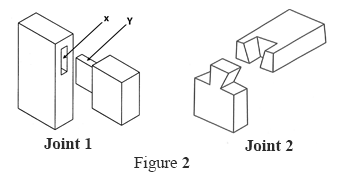1.
How many essential nutrients are there?
5
6
3
7
2.
What are the building blocks of proteins called?
Lipoproteins
Carbon chains
Amino acids
Amino chains
3.
The primary colours are
red, violet, yellow.
red, yellow, blue.
green, yellow, red.
violet, yellow, green.
4.
The plan of a cylinder is a
rectangle.
circle.
square.
triangle.
5.
The methods of cooking that are commonly used in Ghana are
steaming and boiling.
boiling and roasting.
boiling and frying.
baking and boiling.
6.
Food is preserved mainly to
shorten its cooking time.
prolong its life span.
prevent germs from living on it.
dry out water in it.
7.
Anaemia is a deficiency disease caused by lack of
iron
calcium
phosphorous
sulphur
8.
The goitre on a person's neck is caused by lack of
calcium.
iodine.
protein.
vitamin D.
9.
Which of the following instruments is most suitable for drawing horizontal lines?
Tee-square
Protractor
Compass
Set-square
10.
The lightness or darkness in drawing is the
hue.
shade.
tint.
tone.
11.
Any two primary colours mixed together in equal proportions produce a
complementary colour.
neutral colour.
secondary colour.
tint colour.
12.
Which of the following colours is used to represent an earth wire?
Blue
Brown
Red
Yellow
13.
In oblique drawing one side of the object is inclined at an angle of
30.
45.
60.
90.
14.
A sketch is a
collection of different lines.
drawing made with pencil.
finished detailed drawing.
quick drawing in few lines.
15.
A place where artworks are displayed and sold is a
museum.
gallery.
studio.
workshop.
16.
The neutral wire has a colour code of
black.
red.
yellow.
grey.
17.
Which of the following is not a method of temporary termination of a wall?
Toothing
Racking
Indent
Bonding
18.
Brass is made of
copper and tin.
copper and zinc.
lead and tin.
lead and zinc.
19.
Mould boxes are oiled before use to
increase the size of the brick.
prevent brick sticking to the box.
smoothen the surface of the brick.
give the brick a shiny surface.
20.
Turpentine is mixed with
emulsion paint.
oil paint.
lacquer.
thinner.
21.
Sandcrete bricks are made from
cement and clay.
cement and sand.
cement and laterite.
cement and lime.
22.
Which of the following tools are used for boring wood?
Brace and bit
Mortice chisel and mallet
Hammer and cold punch
Hammer and centre punch
23.
In mixing mortar, the ratio 1:5 represents
one part sand to five parts cement.
one part water to five parts cement.
one part cement to five parts sand.
one part cement to five parts gravel.
24.

Which is the correct front view of the figure above?




25.

Which is the correct side view of the figure above?




26.
The soft solder is an alloy of
copper and lead.
copper and tin.
lead and tin.
lead and aluminium.
27.
The first step to be taken when checking a socket outlet for a fault is to
open the socket outlet.
switch off power at the main switch.
test the socket outlet.
remove the mains fuse.
28.
Aggregates used for concrete mixture should be
well graded.
round in size.
square in size.
medium graded.
29.
Which of following is not a property of aluminium?
Light in weight
It corrodes
Absorbs heat readily
It is a good conductor of electricity
30.
The most suitable pencil for freehand sketching is
H
HH
HB
BB
[1 hour 15 minutes]
Paper 2 is in two sections: A and B. Answer three questions only: Question 1 in section A and two questions in section B.
Answer Question 1
[COMPULSORY]
(a)
(i)
What is a seam?
(ii)
State and explain briefly the two types of seam
(iii)
Give one example each of the types of seam stated in (ii) abouve
(iv)
State three factors to consider when choosing the type of seam
(v)
State three characterisitics of a good plain seam
(b)
(i)
State the three classes of food.
(ii)
Give two examples of each class of food stated in (a)(i) above.
(iii)
(α)
State three food nutrients
(β)
State two functions each of the nutrients stated in (ii)(α) above
(γ)
State two sources each of the nutrients stated in (ii)(α) above
(c)
(i)
Define the following terms and give one example each:
(α)
Primary colours;
(β)
Secondary colours;
(γ)
Intermediate colours;
(θ)
Tertiary colours.
(ii)
Complete the table below by filling in the blank spaces.
| Colour | Association in Nature | Symbolism |
| Red | Blood | Danger |
| Sky | ||
| White | ||
| Decay | ||
| Past History | Mourning | |
| Riches | ||
| Orange | ||
| Growth | ||
| Violet/Purple |
(d)
(i)
List three building materials.
(ii)
List four tools for constructing walls.
Answer two questions only from this section.
All questions carry equal marks.
(a)

The figure above shows the pictorial view of a wooden block. Draw full size the following views in the Third Angle Orthographic Projector:
(i)
front elevation in the direction of Z;
(ii)
plan.
(b)
(i)
Define the term marking-out
(ii)
List two types of marking out tools
(iii)
Make a freehand sketch of the tools listed in (b)(ii) and label the parts.
(iv)
Differentiate between the centre punch and the dot punch.
(c)
Copy and complete the table below:
| Process | One tool used |
| Plumbing a wall | |
| Checking corners of a wall | |
| Measuring aggregates | |
| Checking courses of a wall | |
| Picking and spreading mortar | |
| Mixing mortar | |
| Sawing wood along its grain | |
| Filing stepped work and corners | |
| Constructing arc and circles | |
| Fasten drawing paper | |
| Receiving drawing paper | |
| Drawing a horizontal line | |
| Measuring an angle | |
| Cutting metals | |
| Cutting deep holes in wood | |
| Joining electronic components | |
| Filling mortar joints | |
| Make series of dots on a marked outline on a metal workpiece | |
| Driving in and out screws in workpiece | |
| Marking out | |
| Setting-out a wall | |
| Moulding bricks | |
| Cutting a tenon from a piece of wood | |
| Soldering sheet metals |
(d)
List two activities a carpenter should perform to keep the workshop clean.
(a)
(i)
List two types of bench plane.
(ii)
Make a freehand pictorial sketch of the bench plane and label any two parts.
(iii)
State one way of maintaining bench planes
(iv)
State two safety precautions to be taken when planning a piece of timber on the work bench.
(b)
(i)
Make a freehand sketch of each of the following tools and label any two parts:
(α)
Spade
(β)
Shovel
(γ)
Wooden float
(θ)
Hand trowel
(ii)
State one use each of the tools sketched in (b)(i)
(iii)
State one way of maintaining the tools listed in (b)(i)
(iv)
State two qualities of a good mortar.
(c)
(i)
State four causes of accident on a work site.
(ii)
State one way of preventing accidents in the workshop.
(iii)
(α)
List two protective clothing used in the workshop.
(β)
State one reason for wearing the protective clothing listed in (c)(iii)(α) above.
(a)
(i)
Define the following terms:
(α)
walling;
(β)
bonding;
(γ)
course of a block wall.
(ii)
State two types of brick bond
(iii)
State and explain two methods of temporary terminating walls.
(iv)
Sketch each of the methods stated in (a)(iii) above.
(b)
(i)
State two tools for laying building units.
(ii)
Sketch each of the tools stated in (b)(i) above.
(iii)
State one use of each of the tools stated in (b)(i) above.
(iv)
State one way of maintaining each of the tools stated in (b)(i) above
(c)
(i)
Make a freehand sketch of each of the following tools and label any two parts:
(α)
Tenon saw;
(β)
Mortise chisel;
(γ)
Bevelled edge chisel;
(θ)
Sliding bevel
(ii)
State one use each of the sketched tools in (c)(i) above.
(iii)
State one way of maintaining each of the following tools:
(α)
Saws
(β)
Chisels
(γ)
Sliding bevel
(iv)

Use the figure 2 above to answer the questions below:
(α)
Name the type of joints shown in joint 1 and joint 2.
(β)
Identify the parts labelled X and Y.
(γ)
List two types of adhesive materials that can be used to strengthen the joints
(θ)
State two specific tools used for preparing each of joint 1 and joint 2.
(v)
State and explain any two types of metalwork joints.